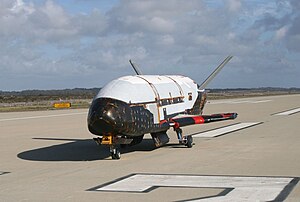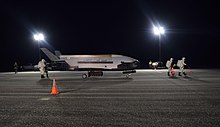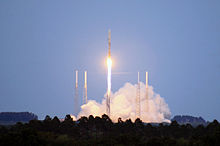Boeing X-37
| Boeing X-37 | |
|---|---|
 X-37B in roll tests |
|
| Type: | Experimental space glider |
| Design country: | |
| Manufacturer: | |
| First flight: |
April 7, 2006 (X-37A) |
| Commissioning: |
In flight testing |
| Number of pieces: |
2 |
X-37 is the name of an experimental, unmanned, reusable type of spacecraft that was originally developed by Boeing Phantom Works , a subsidiary of Boeing , on behalf of NASA . The structure is derived from the previous X-40 experimental glider .
Development history
The X-37 program was started by NASA in 1999. With the help of the X-37, both techniques and maneuvers such as launching and reentrying into the earth's atmosphere are to be tested. Since the space plane but can stop for a longer time in earth orbit, are used for energy supply in space gallium arsenide - solar cells .
The X-37 was originally designed so that it could be transported into orbit in the cargo bay of a space shuttle . As a result of the Columbia crash in February 2003, the glider was modified so that it can be launched on a Delta II rocket without disguise. The Atlas V (501) was later selected as the launcher, as it made it possible to accommodate the X-37 under a payload fairing to avoid aerodynamic problems during take-off.
In September 2004, the US military authority DARPA took over the project for further development from NASA. From summer 2005 test flights of the X-37A prototype took place with the privately developed carrier aircraft Scaled Composites White Knight . The USAF's Rapid Capabilities Office currently directs the X-37B program.
The X-37B should be able to orbit the earth at an altitude of up to 900 km for over a year and be operational again 15 days after its return. In orbit, the orbit height can be changed with the help of an engine . Originally, the 29.3 kN strong and kerosene and hydrogen peroxide powered Rocketdyne AR2-3 engine was planned, but in the course of development this was replaced by a conventional hydrazine drive system with 14.7 kN. A maximum of 250 kg of freight can be transported in the 2.13 x 1.22 meter payload bay.
A first test of the space-suitable variant X-37B (OTV-1: Orbital Test Vehicle 1) in earth orbit was originally planned for the summer of 2006; however, the launch did not take place until April 22, 2010 at 23:52 UTC . An Atlas V (501) was used as the launch rocket and brought the spacecraft from Cape Canaveral into space . This first flight ended after 224 days, 8 hours and 24 minutes in orbit with a completely autonomous landing at the US Air Force Base Vandenberg on December 3, 2010. No details were disclosed about the objectives of the mission and the purpose of the aircraft.
The second copy (OTV-2) was successfully launched on March 5, 2011, also with an Atlas V (501) from Cape Canaveral. The X-37B remained in orbit for more than a year performing systems tests and military experiments. On June 16, 2012, OTV-2 ended its mission and landed on the US Air Force Base Vandenberg after 469 days in space.
On December 11, 2012, the first orbiter took off on its second flight on board an Atlas V (501) for the third X-37B mission (OTV-3) and in March 2014 exceeded the duration of the previous flight. After 674 days in space, it landed on October 17, 2014 at the US Air Force Base Vandenberg, California. On May 20, 2015, the fourth mission of an X-37B - referred to as the "Orbital Test Vehicle 4", (OTV-4) - started into space. It was not identified which of the two orbiters was used. He deployed four small satellites and tested a 32 square meter solar sail and a Hall drive . On March 25, 2017, it exceeded the duration of the previous flight; on May 7, 2017, the landing was carried out for the first time after a total of 718 days in space at the Shuttle Landing Facility in Florida.
The fifth X-37B mission (OTV-5) began on September 7, 2017 with the transport into space by a Falcon 9 rocket from the private space company SpaceX . On August 26, 2019, the X-37B again exceeded the length of stay in space of the previous flight. The landing at the Kennedy Space Center in Florida took place on October 27, 2019 after 780 days in space.
Missions
| mission | Start date ( UTC ) | Launcher | Landing date (UTC) | Duration of the mission | Orbiter | payload |
|---|---|---|---|---|---|---|
| OTV-1 | Apr 22, 2010 11:52 pm | Atlas V (501) | Dec 3, 2010 9:16 am | 224d 9h 24min | 1st orbiter, 1st flight |
unknown |
| OTV-2 | March 5, 2011 10:46 PM | Atlas V (501) | June 16, 2012 12:48 PM | 468d 14h 2min | 2nd orbiter, 1st flight |
unknown |
| OTV-3 | Dec 11, 2012 6:03 pm | Atlas V (501) | Oct 17, 2014 4:24 pm | 674d 22h 21min | 1st orbiter, 2nd flight |
unknown |
| OTV-4 | May 20, 2015 3:05 pm | Atlas V (501) | May 7, 2017 11:47 am | 717d 20h 42min | unknown | Experiments, etc. a. Testing a Hall drive |
| OTV-5 | Sep 7 2017 14:00 | Falcon 9 | Oct 27, 2019 7:51 am | 779d 17h 51min | unknown | u. a. ASETS-II |
| OTV-6 | May 17, 2020 1:14 PM | Atlas V (501) | in orbit | unknown | Experiments, FalconSat-8 satellite | |
Technical specifications
| Parameter | value |
|---|---|
| span | 4.5 m |
| length | 8.9 m |
| height | 2.9 m |
| Takeoff mass | 4990 kg |
| payload | Max. Height 2.13 m max. Diameter 1.22 m max. Mass 250 kg |
See also
Web links
- Some Details of Secretive X-37B Space Plane Revealed . Space.com, April 18, 2010 (English)
- Space Shuttle Junior . KosmoLogs
- X-37B (OTV-1): the game of cat and mouse continues . Raumfahrer.net; Orbit tracking by amateur astronomers
- Astronomie.info: The US Air Force's experimental spacecraft: OTV (Orbital Test Vehicle) - X37 .
- Secretive X-37B Space Plane Discovered in Orbit after Staying Hidden for 218 Days . Spaceflight101, April 13, 2018 (on OTV-5, English)
Individual evidence
- ↑ New American spaceship poses a riddle. Neue Zürcher Zeitung, April 7, 2010, accessed on April 9, 2010 .
- ↑ Boeing Phantom Works boeing.com; Boeing Phantom Works @ en.wikipedia, accessed March 10, 2011
- ^ A b Hans-Christian Dirscherl: X-37B: Secret US spacecraft sets long-term record in space. In: PC world . August 27, 2019, accessed August 30, 2019 .
- ↑ a b The shuttle is dead, long live the shuttle? - US Air Force tests mini space shuttle. In: astronomie-heute.de. Spektrum der Wissenschaft Verlag, March 23, 2010, accessed December 5, 2010 .
- ↑ a b Factsheet: X-37 Orbital Test Vehicle. (No longer available online.) United States Air Force , May 21, 2010, archived from the original on July 1, 2012 ; accessed on November 5, 2010 (English).
- ^ Gero Schmidt: DARPA takes over the X-37 program. raumfahrer.net, September 15, 2004, accessed April 9, 2010 .
- ^ Leonard David: White Knight carries X-37 aloft. CNN, June 23, 2005, accessed April 22, 2010 .
- ↑ Rapid Capabilities Office ( Memento of July 11, 2013 in the Internet Archive ) af.mil, accessed on March 9, 2011
- ↑ Bartt Hebert: Peroxide (H2O2) Test Programs, AR2-3 Flight Certification ( Memento of July 21, 2011 in the Internet Archive ) , SDC Operations, NASA Engineering and Test Directorate, July 24, 2009
- ^ Gary Payton: Under Secretary of the Air Force for Space Programs. (PDF; 181 kB; 2: 40–3: 30 pm; April 20, 2010) Media Teleconference (Pentagon) X-37B Launch 2: 40–3: 30 pm, April 20, 2010. (No longer available online.) 20. April 2010, archived from the original on October 12, 2012 ; accessed on January 5, 2019 .
- ^ Atlas Launch Report - Mission Status Center. Spaceflight Now, April 22, 2010, accessed April 23, 2010 .
- ↑ Test start in Cape Canaveral. ORF, April 22, 2010, accessed on December 5, 2010 .
- ↑ X-37B Orbital Test Vehicle lands at Vandenberg AFB. (No longer available online.) Vandenberg Air Force Base, March 12, 2010, archived from the original on December 6, 2010 ; accessed on December 5, 2010 (English).
- ↑ Second X-37B launched. Raumfahrer.net, March 6, 2011, accessed March 6, 2011 .
- ↑ Secret Space Plane Heading Back Into Orbit. Wired.com, March 3, 2011, accessed June 3, 2012 .
- ↑ US Air Force brings secret mini-shuttle into space. DiePresse.com, March 6, 2011, accessed June 3, 2012 .
- ↑ Officials anticipate more flights of X-37 space plane. spaceflightnow.com, March 7, 2011, accessed June 3, 2012 .
- ↑ Secret space plane has solar stowaway. newscientist.com, March 7, 2011, accessed March 9, 2011 .
- ^ Preparations underway for X-37B landing. (No longer available online.) Vandenberg Air Force Base, May 30, 2012, archived from the original on June 2, 2012 ; Retrieved June 1, 2012 .
- ↑ Air Force's Secretive X-37B Space Plane Will Land Soon. Space.com, May 30, 2012, accessed June 2, 2012 .
- ↑ Secret spaceship of the US Air Force landed in California. orf.at, June 16, 2012, accessed June 18, 2012 .
- ↑ USAF launches X-37B into orbit. In: FlightGlobal. Retrieved December 12, 2012 .
- ↑ Air Force's X-37B Breaks Orbit Record - Defensetech.org, April 1, 2014
- ^ Secret project X-37B: Mini-Space-Shuttle lands in space after two years. In: Spiegel Online . October 17, 2014, accessed October 17, 2014 .
- ↑ Mike Wall: Air Force's Mysterious X-37B Space Plane Breaks Orbital Record. space.com, March 25, 2017, accessed March 28, 2017 .
- ^ A b Justin Ray: X-37B space plane returns to Earth and makes autopilot landing in Florida. Spaceflight Now, May 7, 2017, accessed December 27, 2018 .
- ↑ Hans-Christian Dirscherl: Falcon 9 flies secret space glider of the US Air Force into space. In: PC world. September 7, 2017, accessed August 30, 2019 .
- ↑ a b c Launch Log. In: Spaceflight Now. Retrieved November 1, 2019 .
- ↑ Chris Bergin and William Graham: X-37B lands successfully following 220 days in space. In: Nasaspaceflight.com. December 3, 2010, accessed November 1, 2019 .
- ↑ Mike Wall: Air Force Video Recounts 'Thrilling' Landing of Mystery X-37B Space Plane. In: Space.com. June 21, 2012, accessed November 1, 2019 .
- ↑ Stephen Clark: US military's X-37B space plane lands in California. In: Spaceflight Now. October 17, 2014, accessed November 1, 2019 .
- ↑ Mysterious space glider X-37B has started again. Der Tagesspiegel , May 20, 2015, accessed on May 21, 2015 .
- ↑ Air Force X-37B secret space plane lands after 780 days in orbit. Spacenews, October 27, 2019, accessed October 27, 2019 .
- ↑ ASETS-II. (PDF) August 10, 2017, accessed October 27, 2019 .
- ↑ Stephen Clark: Payloads revealed for next flight of X-37B military spaceplane . Spaceflight Now, May 6, 2020.




